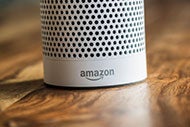

More Patients Are Hearing Bedside Voices — Without a Caregiver Present
 With ever-increasing frequency, virtual assistant devices are finding their way into patient care. A recent report in STAT explains ways hospitals are finding new uses for these devices manufactured by Amazon, Google, Apple, Microsoft and others in areas like intensive care units and surgical recovery rooms. Some are imagining a future in which voice avatars like Alexa become a virtual member of the medical team.
With ever-increasing frequency, virtual assistant devices are finding their way into patient care. A recent report in STAT explains ways hospitals are finding new uses for these devices manufactured by Amazon, Google, Apple, Microsoft and others in areas like intensive care units and surgical recovery rooms. Some are imagining a future in which voice avatars like Alexa become a virtual member of the medical team.
Some believe the devices could be effective in monitoring doctor-patient interactions, suggesting treatment approaches or alerting caregivers to voice changes that could signal a health emergency. The report notes that Northwell Health is preparing to put Alexa in private rooms to allow patients to tap into their medical records, and Mayo Clinic is using voice to deliver wound care instructions to some surgical patients while studying the technology’s ability to help diagnose cardiovascular disease and other conditions.
Boston Children’s Hospital’s Innovation & Digital Health Accelerator, a pioneer in exploring voice-assistant devices, has multiple pilots going in this area. John Brownstein, chief information officer at the hospital, co-authored an article last year in the Harvard Business Review about the voice applications his organization is piloting. One pilot examined using voice systems in the ICU, where clinicians found it highly useful for getting information that otherwise would involve picking up the phone, searching through documents or walking down the hall. In an environment where maintaining sterility and infection prevention are priorities, the voice-enabled technology helped improve safety and efficiency. The hospital, one of the world’s busiest pediatric transplant-surgery facilities, also piloted a real-time, hands-free, voice-prompted checklist process. Early feedback from the pilot team found the voice assistant easy to use and showed potential for reducing human error.



